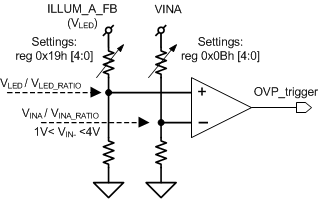DLPS132 May 2018 DLPA4000
PRODUCTION DATA.
- 1 Features
- 2 Applications
- 3 Description
- 4 Revision History
- 5 Pin Configuration and Functions
- 6 Specifications
-
7 Detailed Description
- 7.1 Overview
- 7.2 Functional Block Description
- 7.3
Feature Description
- 7.3.1 Supply and Monitoring
- 7.3.2 Illumination
- 7.3.3 External Power MOSFET Selection
- 7.3.4 DMD Supplies
- 7.3.5 Buck Converters
- 7.3.6 Auxiliary LDOs
- 7.3.7 Measurement System
- 7.4 Device Functional Modes
- 7.5 Programming
- 7.6 Register Maps
- 8 Application and Implementation
- 9 Power Supply Recommendations
- 10Layout
- 11Device and Documentation Support
- 12Mechanical, Packaging, and Orderable Information
Package Options
Mechanical Data (Package|Pins)
- PFD|100
Thermal pad, mechanical data (Package|Pins)
- PFD|100
Orderable Information
7.3.2.6.2 RatioMetric Overvoltage Protection
The DLPA4000 device protects the illumination driver LED outputs against open circuit use. When no LED is connected and the device receives a signal to set the LED current to a specific level, the LED voltage (ILLUM_A_FB) quickly rises and potentially saturates to VIN. The device triggers OVP protection circuit when VLED crosses the specified threshold to prevent this dangerous situation. The OVP protection fault disables the DLPA4000 device.
The device triggers a fault when the supply voltage (VINA) falls too low. A comparator senses both the LED voltage and the VINA supply voltage The fraction of the VINA is connected to the minus input of the comparator while the fraction of the VLED voltage is connected to the plus input. The OVP fault occurs when the plus input rises above the minus input. Set the fraction of the VINA between 1 V and 4 V to ensure proper operation of the comparator.
 Figure 12. Ratio Metric OVP
Figure 12. Ratio Metric OVP
Use register 0x19h bits [4:0] to set the fraction of the ILLUM_A_FB voltage. Use register 0x0Bh bits [4:0] to set the fraction of the VINA voltage. In general the device issues an OVP fault when either Equation 6 or Equation 6 occurs.


Because the OVP level is ratio-metric it can be set to a fixed fraction of VINA.
For example: to maintain a VLED level below 85% of VINA, use these settings:
reg 0x19h [4:0] = 01h (4.98)
reg 0x0Bh [4:0] = 07h (5.85)
Additionally for VIN_RATIO = 5.85 the VIN– input voltage for the comparator is between 1 V and 3.4 V for a supply voltage between 6 V and 20 V.